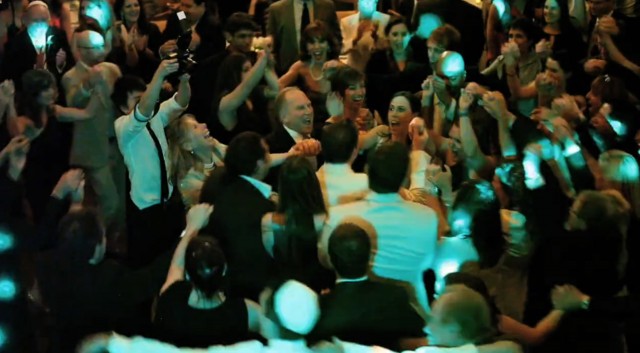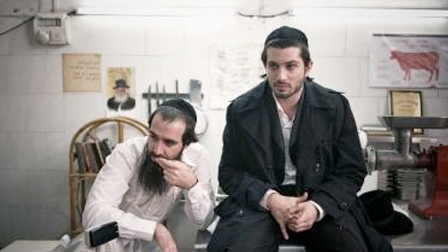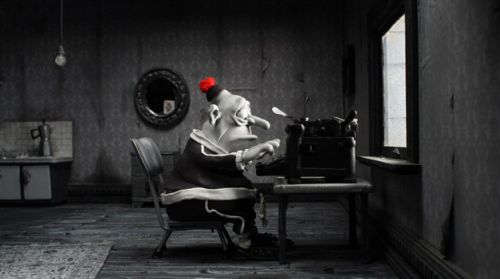
Documentary delves into the fascinating history behind traditional Jewish song that became an international sensation
HAVA NAGILA (THE MOVIE) (Roberta Grossman, 2012)
Lincoln Plaza Cinema, 1886 Broadway between 62nd & 63rd Sts., 212-757-2280
Opens Friday, March 1
www.havanagilamovie.com
www.lincolnplazacinema.com
 “What’s up with this song? So kitschy, yet so profound,” director and narrator Roberta Grossman says at the beginning of her rollicking documentary, Hava Nagila (The Movie). “And what’s the deal with the chair?” A staple at Jewish celebrations, primarily weddings and bar/bat mitzvahs, “Hava Nagila” instantly gets friends and family members out on the dance floor, forming a circle and doing the Hora. Grossman delves into the history and mystery of the catchy song, which over the years has been performed by an unlikely crew that has included Harry Belafonte, Connie Francis, Glen Campbell, Johnny Yune, and Regina Spektor, all of whom appear in the film and discuss the tune’s popularity. (There are also archival performances from all around the world as well as an anti-“Hava” song from Bob Dylan.) Also putting “Hava Nagila” into perspective are Yiddish theater veteran Leonard Nimoy, communications professor Josh Kun, and KlezKamp founder Henry Sapoznik, a “Hava” hater who says with a more than a touch of cynicism, “It’s relentless. It’s resilient. But then again, so are cockroaches,” a statement that exemplifies Grossman’s playful attitude, exemplified by her corny captioning and clever clips from such TV shows and movies as Laugh-In, Curb Your Enthusiasm, Thoroughly Modern Millie, The Danny Kaye Show, A Serious Man, Wedding Crashers, History of the World Part I, and Fiddler on the Roof. But she also reveals another side to the song, as described by professor James Loeffler, who explains, “‘Hava’ is a portal into a century and a half of Jewish history.” Grossman ( Blessed Is the Match: The Life and Death of Hannah Senesh) sets off on what she calls a “Hava Quest,” venturing to the village of Sadagora in Ukraine, the birthplace of the song, and later meeting with two warring families battling over authorship of the words and music. She traces its impact on the development of the State of Israel and the Jewish migration to suburban America, and, yes, she lays out precisely what the words of the song mean. Like the song itself, Hava Nagila (The Movie), which sold out its recent appearance at the New York Jewish Film Festival, is a fun and fanciful frolic into the fascinating story behind one of the most famous songs that so many know so little about.
“What’s up with this song? So kitschy, yet so profound,” director and narrator Roberta Grossman says at the beginning of her rollicking documentary, Hava Nagila (The Movie). “And what’s the deal with the chair?” A staple at Jewish celebrations, primarily weddings and bar/bat mitzvahs, “Hava Nagila” instantly gets friends and family members out on the dance floor, forming a circle and doing the Hora. Grossman delves into the history and mystery of the catchy song, which over the years has been performed by an unlikely crew that has included Harry Belafonte, Connie Francis, Glen Campbell, Johnny Yune, and Regina Spektor, all of whom appear in the film and discuss the tune’s popularity. (There are also archival performances from all around the world as well as an anti-“Hava” song from Bob Dylan.) Also putting “Hava Nagila” into perspective are Yiddish theater veteran Leonard Nimoy, communications professor Josh Kun, and KlezKamp founder Henry Sapoznik, a “Hava” hater who says with a more than a touch of cynicism, “It’s relentless. It’s resilient. But then again, so are cockroaches,” a statement that exemplifies Grossman’s playful attitude, exemplified by her corny captioning and clever clips from such TV shows and movies as Laugh-In, Curb Your Enthusiasm, Thoroughly Modern Millie, The Danny Kaye Show, A Serious Man, Wedding Crashers, History of the World Part I, and Fiddler on the Roof. But she also reveals another side to the song, as described by professor James Loeffler, who explains, “‘Hava’ is a portal into a century and a half of Jewish history.” Grossman ( Blessed Is the Match: The Life and Death of Hannah Senesh) sets off on what she calls a “Hava Quest,” venturing to the village of Sadagora in Ukraine, the birthplace of the song, and later meeting with two warring families battling over authorship of the words and music. She traces its impact on the development of the State of Israel and the Jewish migration to suburban America, and, yes, she lays out precisely what the words of the song mean. Like the song itself, Hava Nagila (The Movie), which sold out its recent appearance at the New York Jewish Film Festival, is a fun and fanciful frolic into the fascinating story behind one of the most famous songs that so many know so little about.


